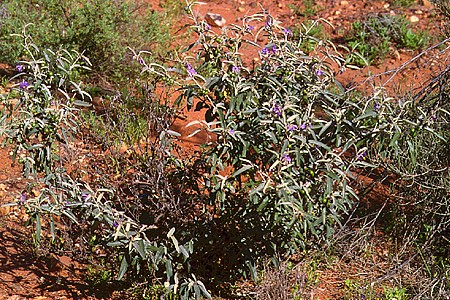
Synonymy
Solanum sturtianum F. Muell., Trans. Philos. Soc. Victoria 1: 19 (1854): see Taxon 35: 270 for discussion of the date of this publication.
S. sturtii F. Muell., Fragm. Phytogr. Austral. 6: 146 (1868), orthographic variant.
T:
Note that this lectotypification was overturned by Bean (2004) since Mueller would not have seen the BM material. The replacement lectotypification is: interior of
S. tetrandrum var. angustifolium A. Morrison, J. Bot. 50: 275 (1912); S. morrisonii Domin, Biblioth. Bot. 89: 577 (1929), based on S. tetrandrum var. angustifolium A. Morrison.
T: Between Globe Hill and Minderoo,
Description
Erect, clonal shrub to 3 m, silvery-green or grey-green, usually densely pubescent with stellate hairs; prickles absent, or 5–6 mm long, scattered to dense on stems, rare elsewhere.
Leaves lanceolate; lamina mostly 30–60 mm long, 5–15 mm wide, discolorous, occasionally concolorous, entire to slightly undulate; petiole 5–15 mm long.
Inflorescence short, few–12–flowered; peduncle absent or to 15 mm long; pedicels 5–8 mm long. Calyx 3–5 mm long; lobes triangular, 1–3 mm long. Corolla rotate-stellate, 30–40 mm diam., purple. Anthers 5–6 mm long.
Berry globular, 10–15 mm diam., yellow to brownish-black, the skin brittle and breaking irregularly. Seeds 3–5 mm long, dark brown to black. n=12.
Another description of the species can be found on the Bean Solanum site at http://delta-intkey.com/solanum/www/sturtian.htm
Distribution and ecology
Widespread in arid areas, extending from central-western W.A. through southern N.T. and S.A. to south-western Qld and north-western N.S.W.
Commonly associated with ranges, occurring in deep gravelly soils of dry creek lines, rarely on rocky slopes.
Common name
Thargomindah Nightshade
Relationships
Part of the S. esuriale group of subgen. Leptostemonum (Bean 2004).
Notes
Ripe fruit reported to be toxic to stressed sheep and cattle in Qld and N.S.W. See for example www.weeds.mangrovemountain.net/data/Solanum%20sturtianum%20-%20Thargomindah%20nightshade.pdf
A distinctive narrow leaved form of this species occurs along the northern margin of its distribution in W.A. This was earlier named S. morrisonii Domin but it is still questionable whether this form should be distinguished.
Asphondylia sturtiana
Kolesik, a gall midge, induces swelling in the stems of Solanum sturtianum.Reference: Kolesik, P., McFadyen, R.E.C. & Wapshere, A.J. (2000). New gall midges (Diptera:Cecidomyiidae) infesting native and introduced Solanum spp. (Solanaceae) in
Germination studies for mine regeneration or the native food industry indicated that germination of seed of this species is promoted by gibberellic acid.
Further illustrations of S. sturtianum can be found in Cunningham et al. (1981: 589); Symon (1981: 205); P.S. Green, Curtis's Botanical Magazine 177: t. 543 (1969).
Derivation of epithet
Named for Charles Sturt (1795-1869), surveyor, explorer and leader of the expedition on which the type specimen was collected.
Selected specimens
W.A.: c. 65 km S of old Mundiwindi, A.S. George 958 (PERTH). N.T.: N of Finke River crossing, N. Byrnes 573 (DNA, NT). S.A.: Paralana Springs, D.E. Symon 6076 (AD, CANB, NSW). Qld: near Thargomindah, M. Olsen 760 & D.E. Boyland (BRI). N.S.W.: Broken Hill, P.L. Milthorpe 868 (NSW).
Plant status, if any
Conservation status as a plant of least concern in the
From the web
Access to further images for S. sturtianum is through the Bean Solanum site at http://delta-intkey.com/solanum/www/sturtian.htm
Further information on this species in NSW can be seen on the PlantNET site, for WA on the FloraBase site and for SA on the eFlora site.
Information and a photo can be found on the Australian Native Plants Society page.
Further information and links for this species can be found on the Solanaceae Source site.




